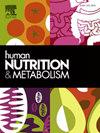Therapeutic potential of Medical Nutrition Therapy (MNT) in Non-Alcoholic Fatty Liver Disease (NAFLD)
IF 1.8
Q3 ENDOCRINOLOGY & METABOLISM
引用次数: 0
Abstract
Background
Non-alcoholic fatty liver disease (NAFLD) is a common liver disorder strongly associated with metabolic syndrome, obesity, and insulin resistance, and is a significant contributor to liver-related morbidity and mortality worldwide. Medical Nutrition Therapy (MNT), focusing on dietary changes that reduce hepatic fat, improve insulin sensitivity, and regulate metabolic markers, is increasingly recognized as a key therapeutic approach for NAFLD management.
Objective
This study assessed the therapeutic potential of MNT in NAFLD patients, focusing on its effects on liver function, metabolic health, and inflammation. Additionally, it examined how educational level and occupation, as components of socioeconomic status, influence MNT effectiveness.
Methodology
A cohort of 200 NAFLD patients was recruited from Tamale Teaching Hospital, Central Hospital, Tamale West Hospital, and Dagbang Medical Centre and randomly assigned to either an MNT intervention group or a control group receiving standard care, which included general dietary recommendations without structured MNT, routine medical follow-up, and lifestyle advice from healthcare providers. Over a 12-month period, patients in the intervention group received personalized MNT, emphasizing a balanced diet, low glycemic index foods, and limited saturated fat intake. Key clinical data, including liver function tests (ALT, AST, GGT), metabolic markers (BMI, weight, fasting glucose, lipid profile), and inflammatory markers (C-reactive protein [CRP], tumor necrosis factor-alpha [TNF-α]), were collected at baseline and after 12 months. Regression analysis with interaction terms assessed the impact of educational level and occupational type on MNT outcomes.
Results
The MNT intervention group showed significant improvements in liver function tests (ALT and AST decreased by 25 % on average, p < 0.01) and metabolic markers (BMI reduced by 3 %, p < 0.01). Inflammatory markers also improved, with CRP and TNF-α levels decreasing significantly compared to the control group (p < 0.01 and p < 0.05, respectively). In contrast, the control group exhibited only minimal changes in these parameters, with non-significant reductions in ALT, AST, BMI, and inflammatory markers (p > 0.05), reinforcing the added benefit of structured MNT over general dietary advice. Higher educational levels and occupations with greater health literacy were independently associated with enhanced outcomes, suggesting that these socio-demographic factors moderated MNT's effectiveness. Therefore, integrating MNT into NAFLD treatment guidelines, enhancing health provider training, expanding access, and prioritizing public education will improve outcomes and prevent disease progression.
Conclusion
MNT effectively manages and provides superior benefits in NAFLD by improving liver function, metabolic health, and inflammation compared to general dietary advice and standard medical care. Socio-demographic factors like education and occupation significantly influenced MNT outcomes in NAFLD management for optimal therapeutic success.
药物营养疗法治疗非酒精性脂肪性肝病的潜力
背景:非酒精性脂肪性肝病(NAFLD)是一种常见的肝脏疾病,与代谢综合征、肥胖和胰岛素抵抗密切相关,是全球肝脏相关发病率和死亡率的重要因素。医学营养疗法(MNT),侧重于减少肝脏脂肪,改善胰岛素敏感性和调节代谢标志物的饮食改变,越来越被认为是NAFLD管理的关键治疗方法。目的本研究评估MNT对NAFLD患者的治疗潜力,重点关注其对肝功能、代谢健康和炎症的影响。此外,它还审查了作为社会经济地位组成部分的教育水平和职业如何影响产妇保健的效力。从Tamale教学医院、中心医院、Tamale西部医院和大邦医疗中心招募了200名NAFLD患者,随机分配到MNT干预组或接受标准治疗的对照组,其中包括不含结构化MNT的一般饮食建议、常规医疗随访和医疗保健提供者的生活方式建议。在12个月的时间里,干预组患者接受个性化的MNT治疗,强调均衡饮食、低血糖指数食物和限制饱和脂肪摄入。在基线和12个月后收集关键临床数据,包括肝功能测试(ALT、AST、GGT)、代谢指标(BMI、体重、空腹血糖、血脂)和炎症指标(c -反应蛋白[CRP]、肿瘤坏死因子-α [TNF-α])。用交互项进行回归分析,评估教育水平和职业类型对MNT结果的影响。结果MNT干预组患者肝功能指标明显改善(ALT、AST平均下降25%,p <;0.01)和代谢指标(BMI降低3%,p <;0.01)。炎症标志物也有所改善,与对照组相比,CRP和TNF-α水平显著降低(p <;0.01和p <;分别为0.05)。相比之下,对照组在这些参数上仅表现出微小的变化,ALT、AST、BMI和炎症标志物均无显著降低(p >;0.05),强化了结构化MNT相对于一般饮食建议的额外益处。较高的教育水平和具有较高健康素养的职业与增强的结果独立相关,表明这些社会人口因素调节了MNT的有效性。因此,将MNT纳入NAFLD治疗指南,加强卫生提供者培训,扩大获取机会,并优先考虑公共教育,将改善结果并预防疾病进展。结论与一般饮食建议和标准医疗护理相比,mnt通过改善肝功能、代谢健康和炎症,有效地管理NAFLD并提供优越的益处。教育和职业等社会人口因素显著影响NAFLD管理中MNT的结果,以获得最佳治疗成功。
本文章由计算机程序翻译,如有差异,请以英文原文为准。
求助全文
约1分钟内获得全文
求助全文
来源期刊

Human Nutrition and Metabolism
Agricultural and Biological Sciences-Food Science
CiteScore
1.50
自引率
0.00%
发文量
30
审稿时长
188 days
 求助内容:
求助内容: 应助结果提醒方式:
应助结果提醒方式:


